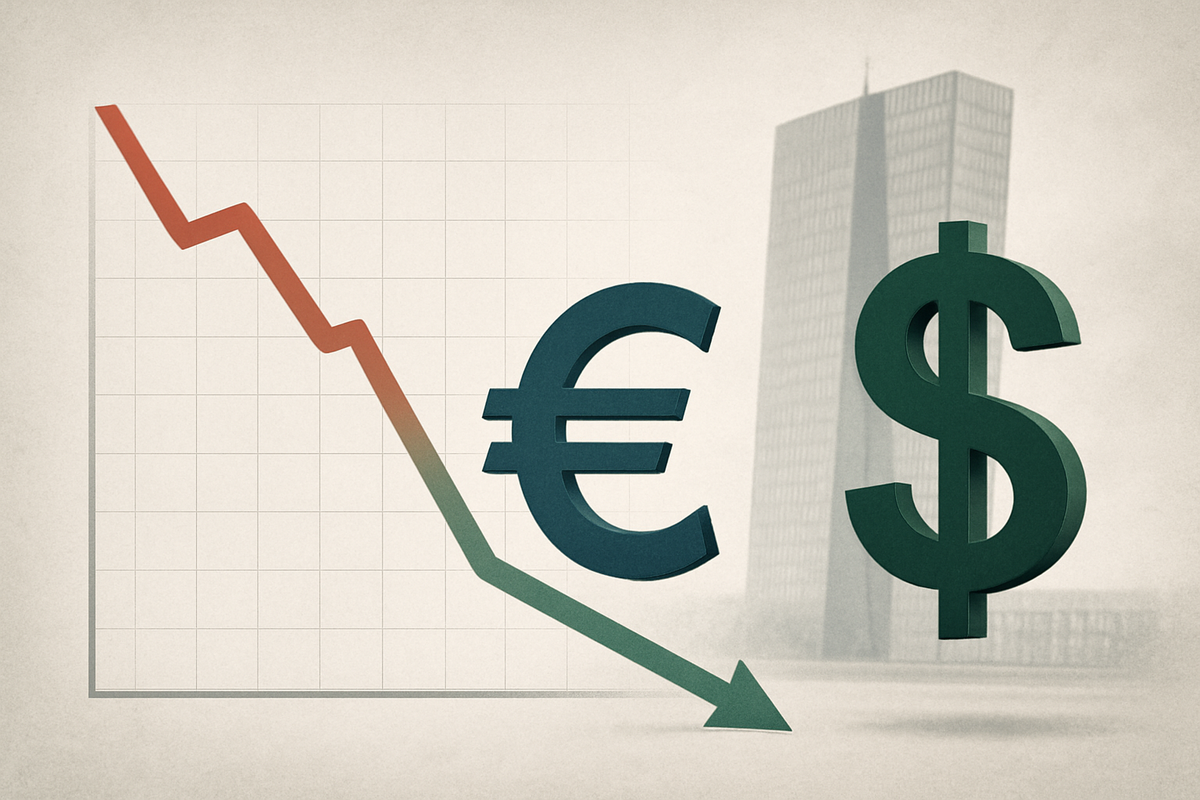
Frankfurt, Germany – October 31, 2025 – The Eurozone is witnessing a significant easing of its headline inflation, a development that is increasingly shaping the trajectory of the EUR/USD exchange rate. With preliminary data for October showing headline inflation at 2.1% year-on-year, inching closer to the European Central Bank's (ECB) 2% target, market dynamics are shifting. This disinflationary trend, coupled with a robust U.S. Dollar, has pushed the EUR/USD pair to around 1.1526, marking a notable weakening trend. Despite the moderating price pressures, the ECB has opted to maintain its benchmark interest rate at 2%, with President Christine Lagarde expressing a cautiously optimistic outlook on the region's economic growth.
The current environment presents a complex picture for investors and policymakers alike. While the deceleration in headline inflation offers a sigh of relief, persistent core inflation, which remains at 2.4%, suggests underlying price pressures are not entirely subdued. The ECB's decision to hold rates steady, following a series of cuts initiated in mid-2024, signals a period of watchful waiting, keen to ensure sustainable price stability without stifling nascent economic recovery. Meanwhile, the strength of the U.S. Dollar, partly driven by a hawkish stance from the Federal Reserve despite a recent rate cut, continues to weigh heavily on the Euro, making the single currency less attractive in a yield-hungry global market.
ECB Holds Firm as Inflation Nears Target
The Eurozone's journey towards price stability has seen notable progress, with preliminary October 2025 headline inflation easing to 2.1% year-on-year, a slight dip from September's 2.2%. This movement brings inflation tantalizingly close to the European Central Bank's (ECB) medium-term target of 2%. However, the picture is not entirely uniform, as core inflation, which strips out volatile components like energy and food, has proven stickier, holding steady at 2.4% in October, slightly above market expectations. This persistence in core prices, particularly in the services sector which recorded a 3.4% annual rate, indicates that underlying inflationary pressures are still at play, albeit gradually receding in other areas such as non-energy industrial goods and energy costs.
In response to this evolving economic landscape, the European Central Bank's Governing Council has maintained a consistent and stable monetary policy. At both its September and October 2025 meetings, the ECB unanimously decided to keep its three key interest rates unchanged. The deposit facility rate remains at 2.00%, the main refinancing operations rate at 2.15%, and the marginal lending facility rate at 2.40%. These decisions follow a series of eight rate cuts implemented since mid-2024, which saw the deposit facility rate reduced from 4.00%. The most recent adjustment was a 25 basis point cut on June 5, 2025. This "on-hold" stance underscores the ECB's data-dependent approach, refraining from pre-committing to future rate paths and prioritizing a sustained return to its 2% inflation target.
ECB President Christine Lagarde, speaking on October 30, 2025, conveyed a message of cautious optimism regarding the Eurozone economy. She affirmed that the Governing Council is "in a good place" from a monetary policy perspective, acknowledging the progress made towards inflation normalization. However, she advocated for continued vigilance and a cautious approach, reinforcing the unanimity behind the decision to hold rates steady. Market analysts largely anticipate the ECB to maintain current rates well into 2026, suggesting that the recent rate-cutting cycle may have concluded for the foreseeable future. Despite this, potential external risks, such as a stronger euro or delays in fiscal stimulus, could still prompt further monetary adjustments if economic conditions warrant.
The immediate market reaction has been a continued weakening of the EUR/USD exchange rate. The divergence in monetary policy signals between the ECB and the US Federal Reserve (Fed) has been a primary driver. While the Fed implemented a 25 basis point rate cut on October 29, 2025, Chairman Jerome Powell's accompanying remarks were interpreted as "hawkish," offering no clear commitment to further cuts and thus bolstering the US Dollar. In contrast, the ECB's firm "on-hold" stance has made the Euro comparatively less attractive to investors seeking higher yields. The EUR/USD pair fell to a two-week low below 1.1580 on October 30, despite stronger-than-expected Eurozone GDP data, and traded around 1.1526 by October 31, reflecting a broader negative trend. The Eurozone economy itself showed resilience, growing 0.2% in Q3 2025, driven by strong performances in countries like Spain and France, even as Germany and Italy faced stagnation. This growth, coupled with moderating inflation, reduces the immediate pressure on the ECB for further rate cuts.
Companies Navigating a Weaker Euro and Stable Rates
The current economic climate in the Eurozone, characterized by easing inflation, a weaker Euro, and stable interest rates, presents a mixed bag of opportunities and challenges for public companies. Sectors with significant export exposure are likely to emerge as beneficiaries, while those reliant on imports or highly sensitive to consumer spending within the Eurozone might face headwinds.
Exporters are generally poised to gain from a weaker Euro. Companies like Airbus SE (EPA: AIR), a leading global aircraft manufacturer, could see their products become more competitive in international markets, particularly against U.S.-based rivals. Similarly, luxury goods conglomerates such as LVMH Moët Hennessy Louis Vuitton SE (EPA: LVMH), with its vast portfolio of international brands, could experience increased demand as their Euro-denominated goods become more affordable for non-Eurozone buyers. German automotive giants like Volkswagen AG (ETR: VOW3) and Bayerische Motoren Werke AG (ETR: BMW) also stand to benefit from enhanced export competitiveness, potentially boosting their sales and profitability in key markets like the United States and Asia. This currency tailwind can translate into higher revenues when foreign earnings are converted back into Euros.
Conversely, importers and companies with significant input costs denominated in stronger currencies, particularly the U.S. Dollar, could face increased expenses. Energy companies, for instance, often purchase oil and gas in USD, meaning a weaker Euro makes these vital imports more expensive. Airlines, such as Deutsche Lufthansa AG (ETR: LHA) or Air France-KLM S.A. (EPA: AF), which procure aircraft parts, fuel, and lease agreements often in USD, could see their operational costs rise, potentially squeezing profit margins. Retailers sourcing a substantial portion of their inventory from outside the Eurozone might also need to absorb higher costs or pass them on to consumers, which could impact sales volume.
The stability of interest rates at 2% has a dual impact. Banks like BNP Paribas S.A. (EPA: BNP) and Banco Santander, S.A. (BME: SAN) might find their net interest margins stabilizing after a period of rate cuts. While further rate cuts are less likely to compress margins, the absence of hikes means they cannot significantly expand them either. Their profitability will increasingly depend on loan growth and cost efficiency. For real estate companies and developers, such as Vonovia SE (ETR: VNA), stable borrowing costs can provide a predictable environment for investment and project financing, although a weaker Euro might deter some international investors looking for Euro-denominated assets. Companies with high levels of variable-rate debt, however, will continue to benefit from the lower interest rate environment compared to peak levels.
Furthermore, companies heavily reliant on domestic Eurozone consumer spending, particularly in sectors where inflation has remained sticky (like services), might face challenges. While overall inflation is easing, persistent core inflation could still erode purchasing power, leading to cautious consumer behavior. Technology companies with a strong Eurozone market presence, such as SAP SE (ETR: SAP), could see demand for their software and services influenced by the overall health of the Eurozone economy. Ultimately, the ability of these companies to adapt to the currency movements, manage input costs, and stimulate demand in a stable, yet cautiously growing, economic environment will determine their success.
Wider Significance: A Glimpse into Global Economic Divergence
The easing of Eurozone inflation, coupled with the European Central Bank's (ECB) steady monetary policy and the weakening of the EUR/USD, carries significant wider implications for global financial markets, trade relationships, and the policies of other central banks. This scenario highlights an increasing divergence in economic trajectories and monetary policy stances among major global economies.
Firstly, the weakening EUR/USD trend, largely driven by the relative strength of the U.S. Dollar and the Federal Reserve's comparatively hawkish tone, signifies a broader shift in global capital flows. Investors, seeking higher returns and stability, may continue to favor dollar-denominated assets, potentially putting further pressure on other currencies. This could lead to a 'dollar smile' effect, where the dollar strengthens both when the U.S. economy outperforms and when global uncertainty rises. For emerging markets, a strong dollar can increase the cost of servicing dollar-denominated debt and make imports more expensive, potentially fueling their own inflationary pressures or requiring their central banks to intervene to stabilize their currencies.
Secondly, the Eurozone's disinflationary path, while positive for consumer purchasing power within the bloc, could impact global trade balances. A weaker Euro makes Eurozone exports more competitive, potentially boosting demand for European goods and services abroad. This could create ripple effects on competitors in other regions, particularly those whose currencies are appreciating against the Euro. Conversely, imports into the Eurozone become more expensive, which could temper domestic demand for foreign goods and services. This dynamic could lead to shifts in trade flows and potentially contribute to trade imbalances, drawing attention from international bodies and trade partners.
The ECB's decision to hold rates steady, following a series of cuts, contrasts with the actions of other central banks globally. While the Federal Reserve recently cut rates, its communication was perceived as hawkish, suggesting a cautious approach to further easing. Other central banks, depending on their domestic inflation and growth dynamics, might find themselves in a challenging position. If their economies are also experiencing easing inflation but their currencies are strengthening against the Euro, they might face pressure to consider their own easing cycles to maintain export competitiveness. Historically, periods of significant monetary policy divergence among major central banks have often led to increased currency volatility and capital market instability, requiring careful navigation from policymakers. For instance, the early 2010s saw similar divergences during the Eurozone sovereign debt crisis and the subsequent quantitative easing by the Fed, leading to sustained periods of dollar strength.
Regulatory implications may also arise as policymakers grapple with the effects of currency fluctuations and differing economic performances. International financial institutions, such as the International Monetary Fund (IMF), may issue warnings about potential risks to global financial stability if divergences become too extreme. Furthermore, governments within the Eurozone might face pressure to implement targeted fiscal policies to complement the ECB's monetary stance, particularly if economic growth remains uneven across member states. The current environment underscores the interconnectedness of the global financial system and the complex interplay between inflation, interest rates, and currency valuations.
What Comes Next: Navigating the Path Ahead
The coming months will be critical for the Eurozone economy, with several key factors shaping its trajectory. In the short term, the European Central Bank (ECB) is widely expected to maintain its "on-hold" stance on interest rates. With headline inflation nearing its 2% target and core inflation proving sticky but manageable, the ECB will likely prioritize observing the sustained impact of its previous rate cuts and the broader economic data. This period of stability in interest rates will provide a predictable environment for businesses and consumers, allowing them to adjust to the new normal. However, any unexpected spikes in energy prices or supply chain disruptions could quickly reignite inflationary pressures, forcing the ECB to reconsider its position.
For the EUR/USD exchange rate, the immediate outlook suggests continued vulnerability to U.S. Dollar strength. The divergence in monetary policy expectations between the ECB and the Federal Reserve, coupled with the perceived resilience of the U.S. economy, will likely keep the Euro under pressure. Analysts anticipate that the EUR/USD could test lower support levels if the Federal Reserve maintains its hawkish rhetoric or if U.S. economic data continues to outperform. However, a significant slowdown in the U.S. economy or a more dovish pivot from the Fed could provide some relief for the Euro. Traders will be closely watching economic indicators from both regions, including employment figures, manufacturing data, and consumer confidence reports, for clues about future currency movements.
In the long term, the Eurozone faces the challenge of sustaining economic growth amidst ongoing geopolitical uncertainties and structural reforms. While President Lagarde's positive sentiments about economic growth are encouraging, the uneven performance across member states, particularly the stagnation in Germany and Italy, highlights underlying fragilities. Potential strategic pivots for Eurozone governments and businesses could involve accelerating green and digital transitions, which could unlock new growth opportunities and enhance competitiveness. Increased investment in infrastructure and innovation will also be crucial for long-term prosperity. Companies may need to adapt their supply chains to be more resilient to global shocks and diversify their market exposure to mitigate currency risks.
Several potential scenarios could unfold. In an optimistic scenario, Eurozone inflation continues its smooth descent to the 2% target, economic growth picks up across all member states, and the global economic environment stabilizes, allowing the ECB to gradually normalize its policy. This would likely see the EUR/USD stabilize or even recover some ground. A more pessimistic scenario could involve a resurgence of inflation due to unforeseen shocks, forcing the ECB to consider rate hikes, which could stifle growth. Alternatively, a prolonged period of weak growth and persistent core inflation could lead to stagflationary concerns. Investors should monitor the ECB's forward guidance closely, alongside inflation expectations and sovereign bond yields, as these will provide critical insights into the central bank's future policy direction and the overall health of the Eurozone economy.
Wrap-Up: Navigating a New Era of Stability and Divergence
The current financial landscape in the Eurozone is defined by a delicate balance of easing inflation, a steadfast European Central Bank (ECB), and a weakening Euro against a resilient U.S. Dollar. The primary takeaway is that while headline inflation is nearing the ECB's target, underlying price pressures, particularly in services, persist. The ECB's decision to hold interest rates at 2% reflects a commitment to a data-dependent approach, prioritizing sustainable price stability over immediate adjustments, and signals a potential end to the recent rate-cutting cycle. This stance, however, creates a significant monetary policy divergence with the U.S. Federal Reserve, which has contributed to the notable weakening of the EUR/USD exchange rate.
Moving forward, the market will likely continue to grapple with this divergence. The U.S. Dollar's strength is expected to persist as long as the Federal Reserve maintains its relatively hawkish posture and the U.S. economy demonstrates resilience. This implies continued pressure on the Euro, making Eurozone exports more competitive but increasing the cost of imports. Companies with significant international exposure, particularly exporters like Airbus SE (EPA: AIR) and LVMH Moët Hennessy Louis Vuitton SE (EPA: LVMH), stand to benefit from the weaker Euro, while importers and those with dollar-denominated costs may face headwinds. The stability of interest rates will provide a predictable environment for lending and investment, benefiting sectors like banking and real estate, though overall economic growth across the Eurozone remains uneven.
Investors should closely watch several key indicators in the coming months. Firstly, the trajectory of core inflation in the Eurozone will be paramount, as its persistence could influence future ECB policy decisions. Secondly, any shifts in the U.S. Federal Reserve's rhetoric or significant changes in U.S. economic data could alter the EUR/USD dynamics. Thirdly, the health of individual Eurozone economies, particularly Germany and Italy, will be crucial for assessing the region's overall growth prospects. Finally, global geopolitical developments and their potential impact on energy prices and supply chains remain significant wildcards. The current environment calls for a nuanced investment strategy, focusing on companies with strong fundamentals, diversified revenue streams, and robust risk management practices capable of navigating currency fluctuations and evolving monetary policy landscapes.
This content is intended for informational purposes only and is not financial advice





